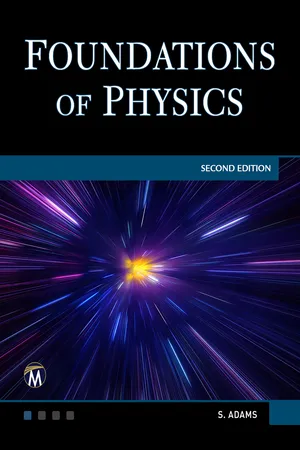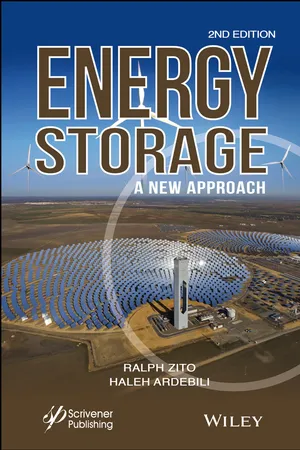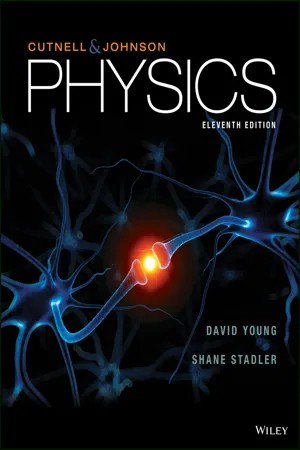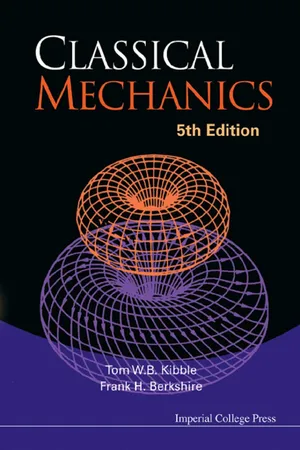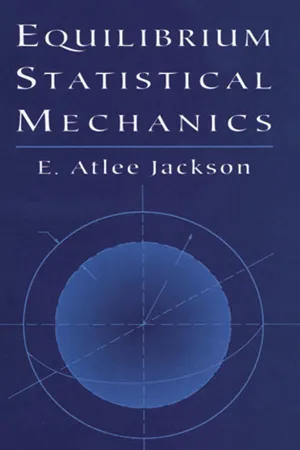Physics
Gravitational Potential Energy
Gravitational potential energy is the energy stored in an object due to its position in a gravitational field. It is directly proportional to the object's mass, the acceleration due to gravity, and its height above a reference point. This energy can be converted into kinetic energy as the object falls, demonstrating the relationship between potential and kinetic energy in physics.
Written by Perlego with AI-assistance
Related key terms
9 Key excerpts on "Gravitational Potential Energy"
- eBook - ePub
- Steve Adams(Author)
- 2023(Publication Date)
- Mercury Learning and Information(Publisher)
g being zero, it isn’t. They are in free fall with the same acceleration as their spacecraft so they do not experience a reaction force to their own weight. The very fact that they are orbiting is because of their weight!23.2 Gravitational Potential Energy AND GRAVITATIONAL POTENTIALGravitational Potential Energy is the energy a body has because of its position in the gravitational field. When it is moved from one position to another energy is either transferred to or from Gravitational Potential Energy. For example, lifting a case from the floor and placing it on a table requires an external agent to apply an upward force and to move this force, so work is done on the case, and its Gravitational Potential Energy increases.If an apple falls from a tree to the ground a gravitational force (its weight) acts on the apple and does work on it, so its Gravitational Potential Energy decreases.23.2.1 Change in Gravitational Potential EnergyConsider a particle of mass m moving from point A to B in a gravitational field as shown below.The work done by the gravitational field to move it a short distance δ x along the line AB is:so the total work done is:where is the scalar product of the two vectors m g and δ x - eBook - ePub
Newtonian Dynamics
An Introduction
- Richard Fitzpatrick(Author)
- 2021(Publication Date)
- CRC Press(Publisher)
The mass falls because it is subject to a downward gravitational force of magnitude m g. It stands to reason, therefore, that the transformation of kinetic into potential energy is a direct consequence of the action of this force. This is, perhaps, an appropriate point at which to note that the concept of Gravitational Potential Energy—although extremely useful—is, strictly speaking, fictitious. To be more exact, the potential energy of a body is not an intrinsic property of that body (unlike its kinetic energy). In fact, the Gravitational Potential Energy of a given body is stored in the gravitational field that surrounds it. Thus, when the body rises, and its potential energy consequently increases by an amount Δ U, in reality, it is the energy of the gravitational field surrounding the body that increases by this amount. Of course, the increase in energy of the gravitational field is offset by a corresponding decrease in the body’s kinetic energy. Thus, when we speak of a body’s kinetic energy being transformed into potential energy, we are really talking about a flow of energy from the body to the surrounding gravitational field. This energy flow is mediated by the gravitational force exerted by the field on the body in question. Incidentally, according to Einstein’s general theory of relativity (1915), the gravitational field of a mass consists of the local distortion that the mass induces in the fabric of space-time. Fortunately, however, we do not need to understand general relativity in order to talk about gravitational fields or Gravitational Potential Energy. All we need to know is that a gravitational field stores energy without loss; that is, if a given mass rises a certain distance, and, thereby, gives up a certain amount of energy to the surrounding gravitational field, then that field will return this energy to the mass without loss if the mass falls by the same distance - eBook - ePub
Energy Storage
A New Approach
- Ralph Zito, Haleh Ardebili(Authors)
- 2019(Publication Date)
- Wiley-Scrivener(Publisher)
2 . The speed of a modern high-speed fly-wheel with electromagnetic bearing can reach as high as 100,000 rpm in vacuum.2.1.3 Gravitational Potential Energy
The problem of defining energy has been attacked in a rather pragmatic fashion. Perhaps, we can approach this concept from a different perspective. For many thousands of years, we have known that lifting weights requires doing what we generally now call “work”, and that weight lifting can be converted into other useful forms of work, such as turning a paddle-wheel, grinding grain, and powering woodworking tools. The energy stored after lifting a weight is referred to as Gravitational Potential Energy.Many thousands of years ago, early humans harnessed this energy by placing heavy stones on high altitudes to be later released for survival and defense. The modern examples of the potential gravitational energy usage include the clock pendulum, water behind a dam, swings, and rollercoasters.To quantify the Gravitational Potential Energy, we must identify relevant parameters including height and mass of the object. We calculate the Gravitational Potential Energy (U) stored in an object, located at a certain position above the ground, by multiplying the mass of the object (m) by gravity (g) times the height (h) expressed as(2.13)where U is in Joules, m is in Kg, g is in m/s2 , and h is in meters.2.1.4 Elastic Potential Energy
Humans have been using uncoiled mechanical springs in bows and arrows for thousands of years, for hunting and survival. When using bows and arrows, we are in fact harnessing the elastic potential energy that was stored in the unoiled springs. As time passed, upon the emergence of coiled springs, the usage of mechanical springs expanded to many common applications including watches.Imagine, as you twist the knob on a watch, you are causing the spring to coil, and thus, you are powering the watch with elastic potential energy. The watch would then uncoil, gradually in time, during the operation and thus, release the stored energy. Figure 2.4 - No longer available |Learn more
- Robert A. Pelcovits, Joshua Farkas(Authors)
- 2023(Publication Date)
- Barrons Educational Services(Publisher)
U to determine the change in the potential energy. Because the net force is constant, the following equation applies:Unless stated otherwise, the +y-direction is generally taken to point up when dealing with Gravitational Potential Energy. Therefore, the work done by gravity as the object moves from y1 to y2 isComparing this equation with the definition of potential energy, W = −ΔU, reveals thatNote that our definition of potential energy involves only the difference in height between the two points. As we will continue to observe, it is only differences in potential energy (and, in this case, differences in height) that are significant. Therefore, we are free to choose any reference point where we define U = 0. For the case of gravity, we choose our reference point to be y = 0, such thatWhat happens if we set y = 0 at a different location? This changes the value of U at a particular point, but recall that it is the difference in potential energy that yields the work and ultimately the change in speed.Only differences in potential energy are significant. The actual magnitude of potential energy at any particular point is arbitrary and depends on the choice of coordinate systems.Potential energy, like work and kinetic energy, is a scalar with units of joules (J = Nm = kg·m2 /s2 ).To review various sign conventions, consider an object falling toward Earth under the influence of gravity. The gravitational force is parallel to the velocity, so gravity performs positive work on the object, increasing its speed (and thus its kinetic energy). The y-coordinate decreases so that U = mgy decreases and thus the potential energy decreases. You can verify that these signs are consistent with the equation Wgravity = −ΔUgravitational = −Δ(mgy) = ΔKE.Example 4.3You lift an object at constant velocity. What are the signs - eBook - ePub
- Robert Lambourne(Author)
- 2019(Publication Date)
- CRC Press(Publisher)
Equation 2.25 provides the expression we said we were seeking for the potential energy of a body due to its gravitational interaction with the Earth. However, since the expression was derived on the basis of Newton’s law of universal gravitation it can be easily generalized. One such generalization is the following:Other generalizations are possible. You may like to think of some for yourself.The Gravitational Potential Energy of two particles of masses m 1 and m 2 , separated by a distance r is(2.26)E grav=.− Grm 1m 23.6 Force as the negative gradient of potential energyYou have now seen several potential energy functions derived from the relevant conservative forces, and you have learned the general technique for deriving others. (Choose a configuration of zero potential energy and calculate the work done by the relevant conservative forces in going from any given configuration to the zero energy configuration.) You have also seen that when the configuration of a system changes, that change generally involves the storage of energy (positive or negative), as a result of which the potential energy changes by an amountΔ(Eqn 2.15)E pot=W cons( final → initial )where W cons (final → initial) is the work that would be done by the conservative force in returning the system to its initial configuration.Now, the total work done by a conservative force when its point of application moves around a closed path is zero, soIt follows thatW cons( final → initial ) +W cons( initial → final ) = 0.W cons( final → initial ) = −W cons( initial → final ) ,and that we may rewrite Equation 2.15 asΔ(2.27)E pot= −W cons( initial → final ) .In other words, any change in potential energy that results from a change in configuration is minus the work done by the relevant conservative force.Now suppose that this change in potential is the result of a body being displaced in one dimension by a small amount Δx while being subject to a conservative forceFxthat acts in the x -direction. If Δx is sufficiently small we can treatFx - eBook - ePub
- John D. Cutnell, Kenneth W. Johnson, David Young, Shane Stadler(Authors)
- 2018(Publication Date)
- Wiley(Publisher)
Section 6.4 explains, a potential energy can be associated with a conservative force. Thus, an electric potential energy exists that is analogous to the Gravitational Potential Energy. To set the stage for a discussion of the electric potential energy, let's review some of the important aspects of the gravitational counterpart.Figure 19.1 , which is essentially Figure 6.10 , shows a basketball of mass m falling from point A to point B. The gravitational force,m, is the only force acting on the ball, where g is the magnitude of the acceleration due to gravity. As Section 6.3 discusses, the work Wg →ABdone by the gravitational force when the ball falls from a height of hAto a height of hBis(6.4)−W=A Bm g⏟h AInitialgravitationalpotential energy ,GPE A=m g⏟h BFinalgravitationalpotential energy ,GPE BGPE A−GPE BRecall that the quantitymghis the Gravitational Potential Energy1 of the ball,GPE = mgh(Equation 6.5 ), and represents the energy that the ball has by virtue of its position relative to the surface of the earth. Thus, the work done by the gravitational force equals the initial Gravitational Potential Energy minus the final Gravitational Potential Energy.Figure 19.1Gravity exerts a force,, on the basketball of mass m. Work is done by the gravitational force as the ball falls from A to B.F →= mg →Interactive Figure 19.2 clarifies the analogy between electric and gravitational potential energies. In this drawing a positive test charge+q0is situated at point A between two oppositely charged plates. Because of the charges on the plates, an electric fieldE →exists in the region between the plates. Consequently, the test charge experiences an electric force,(Equation 18.2 ), that is directed downward, toward the lower plate. (The gravitational force is being neglected here.) As the charge moves from A to B, work is done by this force, in a fashion analogous to the work done by the gravitational force in Figure 19.1 . The work WF →=q 0E →ABdone by the electric force equals the difference between the electric potential energy EPE at A and the electric potential energy at B - eBook - ePub
- Tom W B Kibble, Frank H Berkshire(Authors)
- 2004(Publication Date)
- ICP(Publisher)
Chapter 6
Potential Theory
This chapter is complementary to the preceding ones. In it we shall discuss not the problem of determining the motion of a particle under known forces, but the problem of finding the forces from a knowledge of the positions of other bodies. We deal specifically with gravitational and electrostatic forces obeying the inverse square law, which are determined by the positions of other masses and charges.We return here to the convention whereby = dr/dt. We shall not use rotating frames again until Chapter 9 .6.1Gravitational and Electrostatic Potentials
The Gravitational Potential Energy of a particle of mass m moving in the field of a fixed mass m′ at r′ is −Gmm′/|r − r′|. If we have several masses mj , located at the points r(The fact that the potential energies add follows from the additive property of forces.)j, then the potential energy is the sumSince the mass m appears only as an overall factor, we may define the gravitational potential Φ(r) to be the potential energy per unit massso thatNote that Φ is always negative. (The potential has sometimes been defined to be minus the potential energy per unit mass, and therefore positive. We prefer, however, to retain the direct correspondence between potential and potential energy, so that particles tend to move towards regions of lower potential.)The acceleration of a particle moving under gravitational forces is given bySince this acceleration is independent of the mass m, we may define the gravitational acceleration or gravitational field g(r) byThus (6.2) and (6.3) are all that is needed to calculate the acceleration induced in a particle by a given distribution of masses.The electrostatic case is very similar. We define the electrostatic potential ϕ(r - eBook - ePub
Janice VanCleave's Physics for Every Kid
Easy Activities That Make Learning Science Fun
- Janice VanCleave, Tina Cash Walsh(Authors)
- 2021(Publication Date)
- Jossey-Bass(Publisher)
Instead, energy can be converted, or changed, into another form of energy. In this activity, the mechanical energy of a pendulum will be investigated. Mechanical energy is the summation of an object's potential energy (stored energy) and kinetic energy (energy of moving objects). A pendulum is a weight, called a bob, hung from a fixed point so that it can freely move backward and forward. Each swing of the bob, from one side to the other forms an arc, as shown in Figure 1. Work is done on the pendulum when it is raised to position A. This means that energy is being transferred to the pendulum. When raised, the pendulum gains Gravitational Potential Energy, which is stored energy due to an object's height. When released, gravity pulls the pendulum down and its Gravitational Potential Energy is converted into kinetic energy. Gravity is the force of attraction between any two objects with mass in the Universe. The greater the mass, the greater is an object's gravitational force. Earth is very massive; thus, it attracts objects near or on its surface in a direction toward its center. At position A, the pendulum has maximum Gravitational Potential Energy, which is changed to kinetic energy as the pendulum swings down to position B. From position B to C, the pendulum is moving against the downward force of gravity; thus, it slows. During this upward part of the swing, the pendulum's kinetic energy changes into Gravitational Potential Energy again. FIG 1 The mechanical energy of a pendulum involves the transfer of kinetic energy into potential energy and back to kinetic energy, and so on. It is important to note that the amount of potential energy at position C is less than it was when the pendulum was first lifted to position A (Figure 1). This means the pendulum loses mechanical energy with each swing and each swing is lower and lower until it finally stops - eBook - ePub
- E. Atlee Jackson(Author)
- 2012(Publication Date)
- Dover Publications(Publisher)
r ) and not change the force. Hence, only the difference in the potential energy at two points can be physically significant. To see what this difference represents, consider again Equation (5). We haveTherefore(7)The right side is simply the work done on the particle by the force F when the particle moves a distance d r. If we want to move the particle, we must exert a force − F, so we shall do the work − F· d r = dφ . Thus(8)A few examples will illustrate these points. First, consider the case of the gravitational force. This force is proportional to the mass of the particle and is nearly constant over reasonable distances. Let z be the height above the ground and mg the force (g is the gravitational constant, g 32 ft sec-2 980 cm sec-2 ). Since the force is only in the z direction,F z = − mg (F x = Fy = 0)(The minus sign is there because the force is toward the ground.) Then, according to Equation (4), the Gravitational Potential Energy is(9)The constant in φ has no physical significance, and it can be selected arbitrarily. The work required to raise the particle from the ground to the height z iswhere the last equality follows from (9) regardless of the value of the constant. We see that this agrees with Equation (8). If we set this constant equal to zero, then the total energy of the particle is, in this case,(10)As z decreases (the particle drops toward the ground), ν must increase in such a way that ∈ remains constant. Thus, the decrease in the potential energy is compensated for by the increase in the kinetic energy.For the second example we consider one of the most important simple mechanical systems. A particle is connected to a fixed point (x = 0) by a spring. If the spring obeys Hooke’s law, then the force it exerts on the particle is proportional to the amount the spring is stretched from its undisturbed (equilibrium) length. Assume that the length of the spring, if left undisturbed, is x o . Then, if x is the position of the particle, (x − x o) represents the amount the spring is stretched (or compressed), and Hooke’s law says thatF x = − κ (x − x 0 )where κ is called the force constant (see Figure 1 ). The force is always such as to restore the particle to the point x = x o, for F x < 0 if x > x o, whereas F x > 0 if x < x o . However, when the particle reaches the point x o, it has a large velocity so that it overshoots this point. In other words, it oscillates back and forth past x = x o. This system is an example of a harmonic oscillator.
Index pages curate the most relevant extracts from our library of academic textbooks. They’ve been created using an in-house natural language model (NLM), each adding context and meaning to key research topics.
